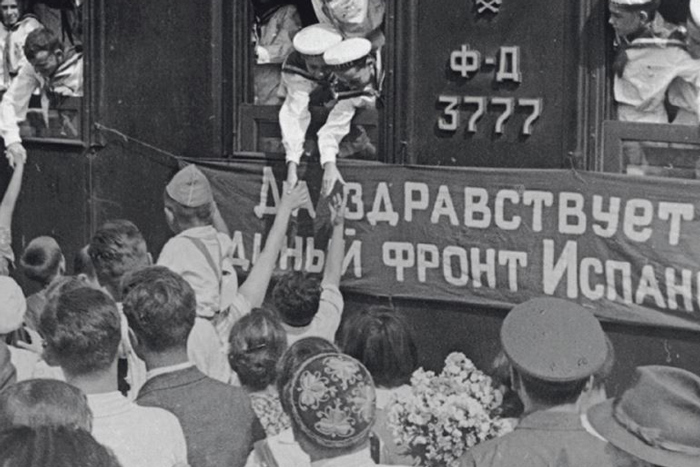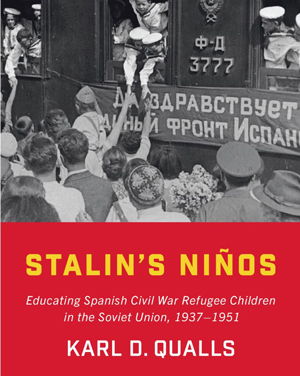With 'Stalin's Niños,' Dickinson College Professor of History Karl Qualls Reveals a Long-Hidden History

Stalin s Ninos cover image.
New faculty publication explores how the Soviet Union took in and educated 3,000 children as refugees from the Spanish Civil War
by Tony Moore

When Professor of History Karl Qualls was in Moscow doing his pre-dissertation work in 1995 and stumbled upon boxes in an archive about Soviet boarding schools for Spanish children, he probably never dreamed it would lead to him publishing a book 25 years later.
But what he found in those boxes—the story of the USSR accepting nearly 3,000 refugee children from the Spanish Civil War—piqued his interest. So, years later, after writing the dissertation, a book and nearly two dozen articles—and finding no record of the occurrence in English and only a few oral histories in Spanish—Qualls returned to the topic.
Now, with Stalin's Niños: Educating Spanish Civil War Refugee Children in the Soviet Union, 1937–1951 Dickinson’s John B. Parsons Chair in the Liberal Arts and Sciences has done just that, bringing to light a history that’s been hidden from English-speaking readers for 70 years. With Qualls’ analysis of archival records and letters, oral histories, and memoirs, he reveals this little-known story exemplifying the Soviet transformation of children into future builders of communism while shining a light on the educational techniques shared with other modern states.
How did these children end up being taken in by the Soviets thousands of miles away from their homeland?
The Soviet case is far different than almost all other receiving countries. These children were from leftist families, supporters of the Spanish Republic that was under attack from the nationalists. Democracies like Great Britain were sympathetic to the proto-fascist coup, so it was up to trade unions and the like to care for about 4,000 children in England, Scotland and Wales. Mexico and the USSR were both socialist/communist governments, so they were the only two to fully support the children financially. Mexico supported just a few hundred niños for a few years. The Soviet Union met all their needs (e.g., food, shelter, health care, education, job training) for 15 years for 3,000 children.
In the USSR, the Spanish Civil War was rightly viewed as the beginning of the great clash with fascism. Democracies around the world, including the United States, were doing nothing to protect the fairly elected government of the republic because it was socialist. So, rather than support a leftist government, they allowed a brutal military coup instead (and this has continued for decades in the U.S.). The Soviet Union was the only country to support the republic against the nationalists and their supporters Nazi Germany and fascist Italy. The Soviet advisors saw firsthand what was going on and felt that they had to do their part in evacuating children. Some of this was for propaganda (hurray for the USSR, saving children from certain death), but a lot of it was a humanitarian urge to save children—and particularly leftist children who could be raised to later return to defeat fascism in Spain.
Did you find that these were children of parents killed in the Spanish Civil War?
It seems that the majority of children were not orphans. Some had lost a parent, usually a father, but many/most had both parents. The parents were sending the children away for their safety. The context is important. The Spanish town of Guernica was destroyed just days after the first big ship of children left. The north coast, from where these kids came, was rapidly crumbling. The main city, Bilbao, which was home to the most kids, fell to the insurgents just about a month after the kids left.
You note in the book that there was a connection between some of the Spanish students raised in the USSR and Castro’s Cuba. What did you uncover regarding these students going on to help Castro in Cuba?
I haven’t been able to get into Cuban archives, and I have seen no other research on the topic. But we do know that a few dozen of these now-grown children went to Cuba as engineers, telecommunications specialists, agronomists and much more. They had the linguistic skills, obviously, but they also had gained higher educations in the Soviet Union that were in great demand in revolutionary Cuba. From the Soviet perspective, they were also good sources of spreading the Soviet version of communism.
What was the biggest surprise you encountered when digging into all of this?
There were a lot of surprises. I think those that come to mind first include these:
- The vast amount of money spent on the niños, far and away more than what was spent per capita on Soviet children. They really were a privileged group.
- The Soviets were much more flexible in their approach to raising these children. Initially the children were raised primarily as Spaniards, but once Franco won the civil war in 1939 and World War II erupted, it was clear the children could not return home without being persecuted (although all other countries sent their niños home). The USSR thus shifted to raising the children as “non-Russian” minorities in the USSR, which meant they began to learn the Russian language more systematically, took classes identical to their Soviet counterparts (except for Spanish language and culture courses) and began to be prepared to enter into Soviet society with a shared set of values, behaviors and experiences. This is why I talk about hybridity and the construction of these children as Hispano-Soviets. They weren’t either/or; they were both/and. Their native language and culture were taught alongside the new Soviet and Russian values.
- The biggest surprise is that no one had told this story before. Spanish scholars have several books based primarily on oral history, but mine is the first book to use systematically the vast files in the Moscow archives dedicated to the Spanish boarding schools and put them in the context of Soviet history. It doesn’t rely on 80-year-old memories. Instead it looks at what the Soviets were trying to do, when, why and how in nearly real time. This has allowed me to tell a much more nuanced story than what we currently have in Spanish. Of course, this also allows me to bring this event to English readers.
You note that countries could take a lesson from this story on how to treat refugees. What lessons do you think could be absorbed by the U.S. in particular?
Putting kids in cages serves no purpose and provides no short- or long-term gain to the U.S. It is brutal and inhumane, undermining our view (right or wrong) of ourselves as a nation and creates tremendous ill will among the detained, their families, their countries and their allies in the U.S.
We have vast uninhabited land in the U.S. When the U.S. illegally rounded up Japanese- and German-Americans in World War II, they put them in camps with buildings, water and electricity, schools and play areas for kids, etc. As appalling as that was, and the conditions were still not adequate, we realized then that children need to be educated and their health protected. If we do so, they can grow up to contribute to society if they stay in the U.S. If, in the present cases, they eventually return to their homelands, they become potential allies because they were treated humanely.
Of course, there is a financial outlay to maintain these conditions, but the long-term benefit would dramatically outweigh the short-term cost. This is what the USSR did with the niños. The children grew up to be contributing members of society and overwhelmingly remember their treatment fondly. Even those who chose to return to Spain or go elsewhere have established groups and hold reunions to relive those years, advance an internationalist perspective and even in some cases teach Russian.
TAKE THE NEXT STEPS
Published June 2, 2020